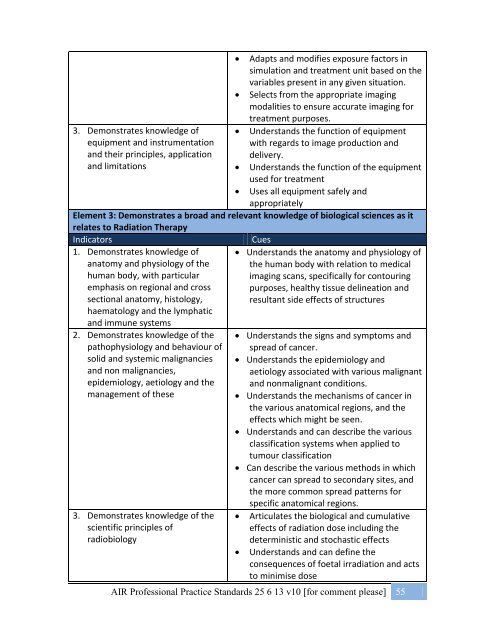Australian-Professional-Standards-Practices
Create successful ePaper yourself
Turn your PDF publications into a flip-book with our unique Google optimized e-Paper software.
3. Demonstrates knowledge of<br />
equipment and instrumentation<br />
and their principles, application<br />
and limitations<br />
• Adapts and modifies exposure factors in<br />
simulation and treatment unit based on the<br />
variables present in any given situation.<br />
• Selects from the appropriate imaging<br />
modalities to ensure accurate imaging for<br />
treatment purposes.<br />
• Understands the function of equipment<br />
with regards to image production and<br />
delivery.<br />
• Understands the function of the equipment<br />
used for treatment<br />
• Uses all equipment safely and<br />
appropriately<br />
Element 3: Demonstrates a broad and relevant knowledge of biological sciences as it<br />
relates to Radiation Therapy<br />
Indicators<br />
Cues<br />
1. Demonstrates knowledge of • Understands the anatomy and physiology of<br />
anatomy and physiology of the the human body with relation to medical<br />
human body, with particular<br />
imaging scans, specifically for contouring<br />
emphasis on regional and cross purposes, healthy tissue delineation and<br />
sectional anatomy, histology,<br />
resultant side effects of structures<br />
haematology and the lymphatic<br />
and immune systems<br />
2. Demonstrates knowledge of the<br />
pathophysiology and behaviour of<br />
solid and systemic malignancies<br />
and non malignancies,<br />
epidemiology, aetiology and the<br />
management of these<br />
3. Demonstrates knowledge of the<br />
scientific principles of<br />
radiobiology<br />
• Understands the signs and symptoms and<br />
spread of cancer.<br />
• Understands the epidemiology and<br />
aetiology associated with various malignant<br />
and nonmalignant conditions.<br />
• Understands the mechanisms of cancer in<br />
the various anatomical regions, and the<br />
effects which might be seen.<br />
• Understands and can describe the various<br />
classification systems when applied to<br />
tumour classification<br />
• Can describe the various methods in which<br />
cancer can spread to secondary sites, and<br />
the more common spread patterns for<br />
specific anatomical regions.<br />
• Articulates the biological and cumulative<br />
effects of radiation dose including the<br />
deterministic and stochastic effects<br />
• Understands and can define the<br />
consequences of foetal irradiation and acts<br />
to minimise dose<br />
AIR <strong>Professional</strong> Practice <strong>Standards</strong> 25 6 13 v10 [for comment please] 55

















